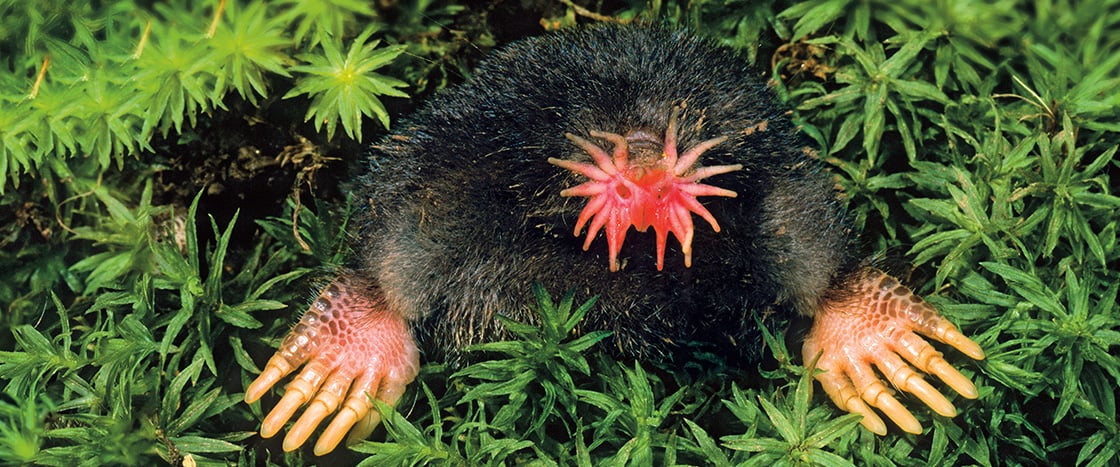With what looks like 22 fleshy worms wriggling in the center of its face, the starnosed mole may be the world’s strangest-looking mammal. The rodent spends much of its time underground, tunneling through the dirt with its outsized feet. It’s dark down there, and the mole doesn’t have strong vision. But the pink tentacles on its nose sense its environment. They poke through the dirt, helping the mole form a picture of its surroundings.

Standards
DWIGHT KUHN
The star-nosed mole is found in wetlands and other places with moist soil in eastern North America. It eats mainly earthworms and insects. But it can also hunt snails, small amphibians, and fish! The star-nosed mole is common, but it’s very hard to spot. That’s because it rarely pokes its head aboveground. Read on to learn more about what makes this mole one of nature’s coolest creatures.
DWIGHT KUHN
Star Predator
The star-nosed mole is considered the world’s fastest eater. Its super-sensitive nose helps it hunt at lightning speed. If a worm or insect brushes against a tentacle, the mole senses it and gobbles it down in less than a quarter of a second. It can eat half its body weight in one day!
KENNETH CATANIA
Tiny, supersensitive organs cover each tentacle on the mole’s nose.
Super-Sensing Nose
Most noses detect smells. The star-nosed mole’s nose is more important for its sense of touch. Each tentacle on its nose is covered with tiny bumps called Eimer’s organs. They contain nerve cells that send messages to the mole’s brain—fast! With about 25,000 Eimer’s organs, the snout is five times more sensitive to touch than the human hand.
KENNETH CATANIA
The moles can smell prey underwater by blowing bubbles.
Testing the Waters
Star-nosed moles are not only great diggers. They’re also excellent swimmers. The moles have a special technique to find prey underwater. As they swim, they blow bubbles over their tentacles and quickly inhale the trapped air inside. They can smell animals hiding nearby.
DWIGHT KUHN
4.6 inches long
Star-nosed moles have short, cylindrical bodies covered in dense, dark fur.
BEFORE READING:
- Project the article in presentation view. (This view can be accessed by clicking on the digital article and selecting the “Presentation View” on the left-hand toolbar.)
- Use the spotlight tool to show students the large image of a star-nosed mole. Share the graphic organizer I Notice, I Wonder with students.
- Have students list observations in the left-hand column and then ask questions in the right-hand column. Encourage them to make as many observations and ask as many questions as they can based on what they see.
DURING READING:
- Read the introduction on page 16. Have students check off and discuss questions that were answered in the text. Then examine the article’s additional images and captions, discussing questions that are being answered. Have students highlight questions that remain unanswered on their graphic organizer.
- Summarize what students have learned about a star-nosed mole’s adaptations, or body parts and behaviors that help it survive. Explain to students that a star-nosed mole that has a superfast reaction time probably catches more prey than a star-nosed mole that isn’t as quick. This is one example of how adaptations help star-nosed moles survive. Discuss other ways a star-nosed mole is adapted to live in a dark underground environment.
AFTER READING:
- Let students reread the text independently and summarize what they learned about star-nosed moles and their adaptations. For students who need more support, share sentence starters like: One adaptation that star-nosed moles have is ________________. This adaptation helps them survive because ________________.
- Circlebacktostudents’unansweredquestions.Discusshowthosecouldbeanswered,usingreputablesources from the internet or books from the library. Let students find the answer to one or more remaining questions about star-nosed moles.
TAKE IT FURTHER:
